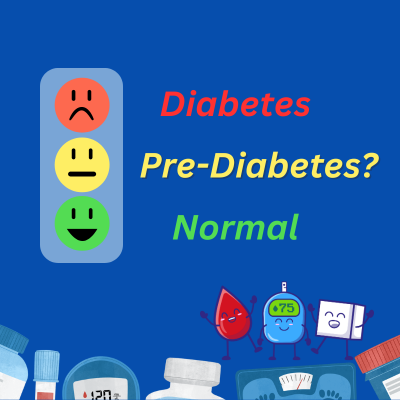It is also known as Intermediate Hyperglycemia.
- It’s a condition where in individuals have higher than normal blood glucose levels, but not high enough to be diagnosed as diabetes.
- Individuals with pre-diabetes are at a higher risk of developing type 2 diabetes; diabetes late complications and cardiovascular disease.
- The increase of desk jobs, extensive use of technology, and lack of fitness activities with consumption of processed foods, sugary beverages, and high calorie snacks have all helped in increase in weight. it often leads to increase in risk of pre-diabetes.
- Generally 2 different pre-diabetic states can be identified in individuals,
- Impaired fasting glucose (IFG)
- Impaired glucose tolerance (IGT)
Pre-diabetes does not usually have any signs and symptoms. but some common symptoms are
Fatigue
Increase thirst
Frequent urination
numbness or tingling in the feet or hands
unintended wright loss
you can have pre-diabetes for years without developing any symptoms.

The Pre-Diabetic population with increased chances of subsequent diabetes is on a rise and is unaware about the condition
What are the Categories and Diagnosis of Pre-Diabetes?
- Pre-diabetes is classified as an intermediate category between the absence & development of diabetes.
- one in five healthy person can have pre diabetes. with a proper intervention it can be reversed.
- It is noted as a stage in a group of individuals whose glucose levels don’t meet the diagnostic criteria for diabetes, but are too high to be considered normal.
- IFG( Impaired Fasting Glucose) category includes those individuals whose FPG (fasting plasma glucose) levels range between 110 & 125 mg/dL or 6.1 to 6.9mmol/L
- Individuals are categorized as having IGT ( Impaired Glucose Tolerance ) when the 2-hour plasma glucose (PG) in the 75 hm OGTT ( Oral glucose tolerance test ) is between 140 & 200 mg/dL or 7.8 & 11.1 mmol/L.
Unless you are unaware that you are pre diabetic till then you will not know a serious health problem arises.
People with a family history of diabetes are more likely to develop diabetes and they must keep a close check on their blood sugar level through regular self-monitoring of blood sugar.
This will help pre-diabetic people become more aware of their blood sugar levels and understand how their lifestyle choices impact those levels.
Overweight people or they have family history of diabetes should start screening themselves for their blood sugar levels. people with PCOS should also do the same.
Body fat especially around the belly is linked to insulin resistance.
watching your carb intake can help avoid blood sugar spikes
Pre-diabetes is reversible but for that you have to act fast.
With improving your lifestyle habits and regular monitoring of sugar levels will ensure that you are able to identify pre-diabetes at an early stage. and prevent it from progressing to any serious health complication.
References:
IDF diabetes atlas edition 9th. diabetesatlas.org accessed Jan 5,2024
